See below CBSE Class 12 Mathematics Sample Paper Set J with solutions. We have provided CBSE Sample Papers for Class 12 Mathematics as per the latest paper pattern issued by CBSE for the current academic year. All sample papers provided by our Class 12 Mathematics teachers are with answers. You can see the sample paper given below and use them for more practice for Class 12 Mathematics examination.
SECTION A
Question numbers 01 to 04 carry 1 mark each.
1. State the reason why the relation R = {(a, b) : a ≤ b2} on the set R of real numbers is not reflexive.
Sol. As 1/2 > (1/2)2 ⇒ (1/2 ,1/2) ∉ R. Hence R is not reflexive.
2. If A is a square matrix of order 3 and | 2A| = k |A| , then find the value of k.
Sol. As |2A| = k |A| ⇒ 23 | A| = k |A | ∴ k = 8 .
3. If a̅ and b̅ are two non-zero vectors such that a̅ × b̅ = a̅ .b̅ , then find the angle between a̅ and b̅.
Sol.

4. If * is a binary operation on the set R of real numbers defined by a * b = a + b – 2, then find the identity element for the binary operation *.
Sol. Let e be the identity element. Then a *e = a = e*a .
So, a *e = a ⇒ a + e − 2 = a ∴ e = 2 .
SECTION B
Question numbers 05 to 12 carry 2 marks each.
5. Simplify

Sol.

6. Prove that the diagonal elements of a skew symmetric matrix are all zero.
Sol. Let A be a skew-symmetric matrix. Then by def., AT = −A
So, the (i, j)th element of AT = the (i, j)th element of ( −A)
⇒ the (j, i)th element of A = −the (i, j)th element of A
For the diagonal elements, i = j then, the (i, i)th element of A = − the (i, i)th element of A
⇒ 2 × the (i, i)th element of A = 0 ∴ the (i, i)th element of A = 0
Hence the diagonal elements of a skew symmetric matrix are all zero
7.

Sol.

8. If x changes from 4 to 4.01, then find the approximate change in loge x .
Sol. Let y = loge x, x = 4, Δx = 0.01

9. Find

Sol.

10. Obtain the differential equation of the family of all circles, passing through the points (a, 0) and
(−a,0) .
Sol. Note that the circle passes through (a, 0) and (–a, 0), which are on x-axis. So, the chord joining
these two points is bisected at (0, 0). Also we know that the diameter is perpendicular to the chord at its midpoint. Hence the centre of the circle must lie on y-axis. Let centre be at (0, b) {or, centre can be taken as (0, –b)}.
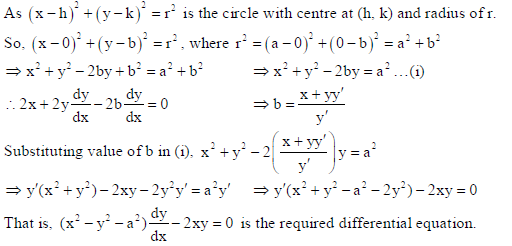
11. If | a̅ + b̅ | = 60, | a̅ − b̅ | = 40 and | a̅ | = 22 , then find | b̅ |.
Sol. As | a̅ + b̅ |2 + | a̅ − b̅ |2 = 2(| a̅ |2 + | b̅ |2 )
⇒ 602 + 402 = 2(222+ | b̅ |2 ) ⇒| b̅ |2 = 2116
Hence | b̅ | = 46.
12. If P(A) = 2/5 , P(B) = 1/3, P(A∩B) = 1/5, then find P(A | B) .
Sol.
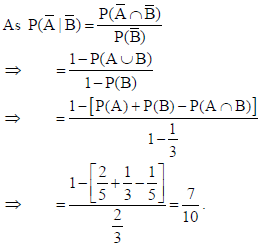
SECTION C
Question numbers 13 to 23 carry 4 marks each.
13.

solve the following system of equations :
x − 2y = −1, 2x + y = 2
Sol.

By equality of matrices, we get : x = 3/5, y = 4/5 .
14. Discuss the differentiability of the function

Sol. Note that f (1/2) = 3 − 6 × 1/2 = 0

Since Rf ‘(1/2) = Lf ‘(1/2) so, f isn’t differentiable at x = 1/2.
OR
For what value of k, is

Sol.
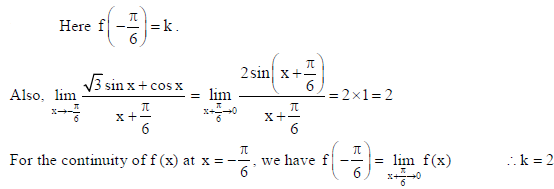
15. If x = a sin pt, y = bcospt , then show that

Sol. Here x = a sin pt, y = bcospt
Differentiating w.r.t. t,
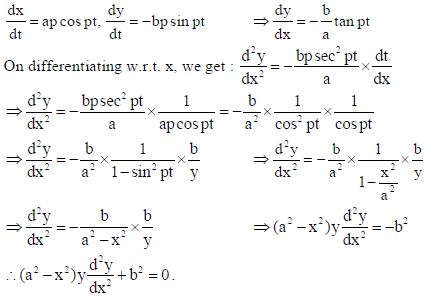
16. Find the equation of the normal to the curve 2y = x2 , which passes through the point (2, 1).
Sol.
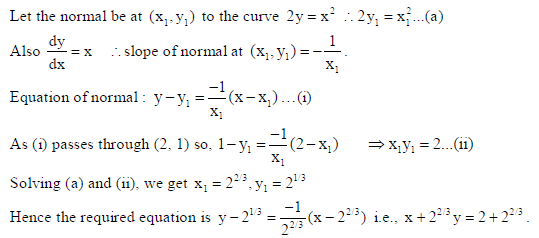
OR
Separate the interval [0,π/2] into subintervals in which f (x) = sin4 x + cos4 x is strictly increasing or strictly decreasing.
Sol.


17. A magazine seller has 500 subscribers and collects annual subscription charges of Rs 300/- per subscriber. She proposes to increase the annual subscription charges and it is believed that for every increase of Rs 1/-, one subscriber will discontinue. What increase will bring maximum income to her? Make appropriate assumptions in order to apply derivatives to reach the solution. Write one important role of magazines in our lives.
Sol. Let the seller increases Rs x in annual subscription.
∴ Total revenue generated by her, R(x) =Rs (300 + x)(500 − x) [1+1/2]
Diff. w.r.t. x both sides, R'(x) = −(300 + x) + (500 − x) = 200 − 2x
Again diff. w.r.t. x, R'(x) = −2
For the points of local maxima & local minima, R'(x) = 0 ⇒ x =100
Now, R'(x =100) = −2 < 0 ∴ R(x) is maximum at x =100 .
So, an increment of Rs 100 will maximize the profit.
Important role of magazines in our lives : Magazines contribute a great deal, to the development of our knowledge. Through valuable and subtle critical and commentary articles on culture, social civilization, new life style we learn a lot of interesting things. Through reading magazines, our mind and point of view are consolidated and enriched.
18. Find

Sol.

19. Find the general solution of the differential equation (1+ tan y)(dx − dy) + 2xdy = 0 .
Sol.

OR
Solve the differential equation

Sol.

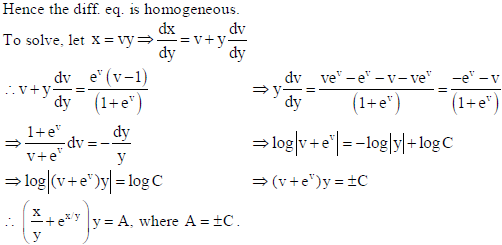
20. Prove that a̅ .{(b̅ + c̅)×(a̅ + 2b̅ + 3c̅)} = [a̅ b̅ c̅]
Sol. LHS : a̅ .{(b̅ + c̅)×(a̅ + 2b̅ + 3c̅)} = a̅ .{b̅×a̅ + 2b̅×b̅ + 3b̅×c̅ + c̅×a̅ + 2c̅× b̅ + 3c̅×c̅}
⇒ = a̅ .{b̅×a̅ + 0¯ + 3b̅×c̅ + c̅×a̅ + 2c̅× b̅ + 0}
⇒ = a̅ .b̅×a̅ + 3(a̅ .b̅×c̅) + a̅ .c̅×a̅ + 2(a̅ .c̅×b̅)
⇒ = [a̅ b̅ a̅]+ 3[a̅ b̅ c̅]+[a̅ c̅ a̅]+ 2[a̅ c̅ b̅]
⇒ = 0 + 3[a̅ b̅ c̅]+ 0 − 2[a̅ b̅ c̅] = [a̅ b̅ c̅] = RHS
21. Find the values of a so that the lines

Sol.

The d.r.’s of lines L1 and L2 are respectively 2, 3, 4 and 5, 2, 1
As 2 :3: 4 ≠ 5: 2 :1, ∴ the lines are not parallel .
Now coordinates of any random point on the lines L1 and L2 are respectively
(2λ +1,3λ + 2,λ + a ) and (5μ + 4, 2μ +1,μ) .
Lines will be skew if, apart from being non-parallel, they do not intersect each other. So, there must not exist a pair of values of λ and μ which satisfy the following three equations
simultaneously : 2λ +1 = 5μ + 4, 3λ + 2 = 2μ +1, 4λ + a = μ
Solving the first two equations, we get : λ = −1= μ .
If these values of λ and μ satisfy the third equation then, the lines will be intersecting each
other and hence won’t be skew lines.
So, for lines L1 & L2 to be skew, we must have 4λ + a ≠ μ i.e., 4×(−1) + a ≠ −1 ∴ a ≠ 3.
22. A bag contains 4 green and 6 white balls. Two balls are drawn one by one without replacement. If the second ball drawn is white, what is the probability that the first ball drawn is also white?
Sol. Let E1 : first ball drawn is white , E2 : first ball drawn is green , A : second ball drawn is white .


23. Two cards are drawn successively with replacement from a well shuffled pack of 52 cards. Find the probability distribution of the number of diamond cards drawn. Also find the mean and the variance of the distribution.
Sol. Let X denote the random variable for the diamonds cards ∴ X = 0,1, 2.
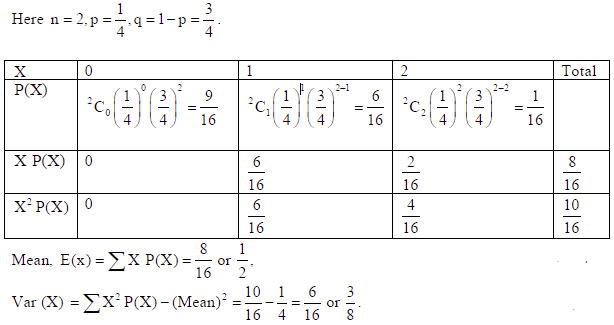
SECTION D
Question numbers 24 to 29 carry 6 marks each.
24. Let f :[0,∞)→R be a function defined by f (x) = 9x2 + 6x −5 . Prove that f is not invertible. Modify, only the codomain of f to make f invertible and then find its inverse.
Sol. Let y = f (x) ∀ x ∈ [0,∞)
∴ y = 9×2 + 6x −5 = (3x +1)2 − 6
Clearly when x ∈ [0,∞) then y ≥ −5 ∴ Range of f = [−5,∞) ≠ Codomain of f
Hence f is not onto and, therefore f (x) is not invertible.
Let us take the modified codomain of f as [−5,∞) .
Let’s now check whether f is one-one : Let 1 2 x , x ∈ [0,∞) such that 1 2 f (x ) = f (x )
⇒ (3x +1)2 − 6 = (3x2 +1)2 − 6 ⇒ 3x1 +1 = 3x2 +1 ⇒ x1 = x2 . So, f is one-one.
Since, with the modified codomain, we have range of f = new codomain of f. So, f is onto.
Hence f is bijective function and, therefore f is invertible.
Now for any y ∈ [−5,∞), y = (3x2 +1)2 − 6

OR
Let * be a binary operation defined on Q×Q by (a, b) * (c, d) = (ac, b + ad), where Q is the set of rational numbers. Determine, whether * is commutative and associative. Find the identity element for * and the invertible elements of Q×Q.
Sol. Let A = Q×Q, where Q is the set of all rational numbers, and * be a binary operation on
A defined by (a, b)*(c,d) = (ac, b + ad) for (a, b),(c,d) ∈ A.
Note that (1,2)*(2,3) = (2,5) and (2,3)*(1, 2) = (2,7) which implies (2,5) ≠ (2,7)
That is, (a, b)*(c,d) ≠ (c,d)*(a, b) ∀ (a,b),(c,d) ∈ Q×Q. So, * isn’t commutative.
Let (a, b),(c,d),(e,f ) ∈ Q×Q.
Now [(a, b)*(c,d)]*(e,f ) = (ac,b + ad)*(e,f ) = (ace,b + ad + acf )…(i)
Also, (a, b)*[(c,d)*(e,f )] = (a,b)*(ce,d + cf ) = (ace, b + ad + acf )…(ii)
By (i) and (ii), [(a,b)*(c,d)]*(e,f ) = (a, b)*[(c,d)*(e,f )] .
Hence * is associative.
Let (e,e’) be the identity element of * in A. Then (a, b)*(e,e’) = (a,b) = (e,e’)*(a, b)

25. Using properties of determinants, prove that

Sol.
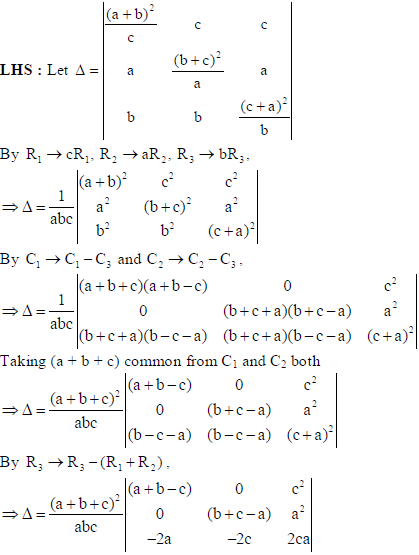

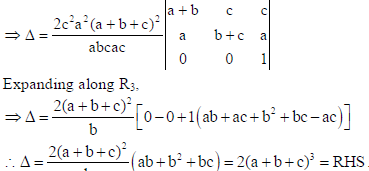
OR

then, using properties of determinants, prove that at least one of the following statements is true :
(a) p, q, r are in G.P.
(b) α is a root of the equation px2 + 2qx + r = 0 .
Sol.
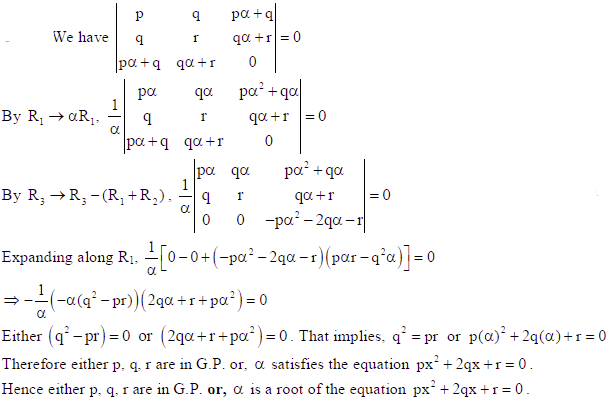
26. Using integration, find the area of the region bounded by the curves

Sol.

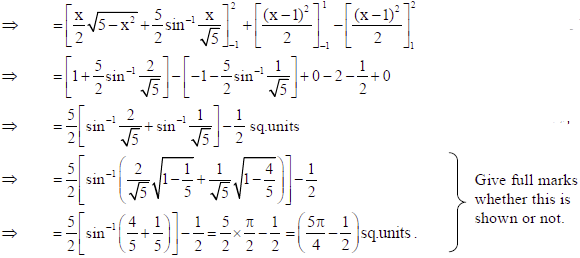
27. Evaluate :

Sol.

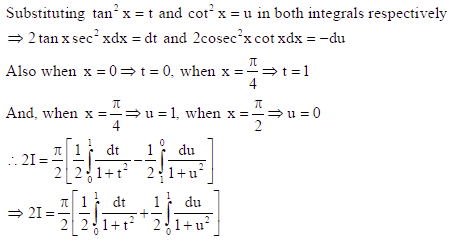

OR
Evaluate

Sol.


28. Find the equation of the plane through the point (4, –3, 2) and perpendicular to the line of intersection of the planes x − y + 2z = 3 and 2x − y − 3z = 0 . Find the point of intersection of the line r̅ = î + 2ĵ− k̂ + λ(î + 3ĵ−9k̂) and the plane obtained above.
Sol. The normal vectors to the planes x − y + 2z = 3 and 2x − y − 3z = 0 are respectively î − ĵ+ 2k̂
and 2î − ĵ−3k̂ .

The equation of required plane through (4, –3, 2) is, r̅.(5î + 7ĵ+ k̂) = (4î −3ĵ+ 2k̂).(5î + 7ĵ+ k̂ ) That is, r̅.(5î + 7ĵ+ k̂ ) =1…(i) is the equation of required plane.
Now for the point of intersection of plane (i) and line r̅ = î + 2ĵ− k̂ + λ(î + 3ĵ−9k̂) , we have
[î + 2ĵ− k̂ + λ(î + 3ĵ− 9k̂ )].(5î + 7ĵ+ k̂ ) =1 ⇒ 5+14 −1+ λ(5+ 21−9) =1 ⇒λ = −1
So, position vector of the required point is r̅ = î + 2ĵ− k̂ + (−1)(î + 3ĵ− 9k̂ ) = 8k̂ − ĵ.
So the point of intersection si (0, –1, 8).
29. In a mid-day meal programme, an NGO wants to provide vitamin rich diet to the students of an MCD school. The dietician of the NGO wishes to mix two types of food in such a way that vitamin contents of the mixture contains at least 8 units of vitamin A and 10 units of vitamin C. Food 1 contains 2 units per kg of vitamin A and 1 unit per kg of vitamin C. Food 2 contains 1 unit per kg of vitamin A and 2 units per kg of vitamin C. It costs Rs 50/- per kg to purchase Food 1 and Rs 70/- per kg to purchase Food 2. Formulate the problem as LPP and solve it graphically for the minimum cost of such a mixture.
Sol. Let x kg of Food 1 be mixed with y kg of Food 2.
To minimize Z = Rs (50x + 70y)
Subject to the constraints : 2x + y ≥ 8, x + 2y ≥10,x ≥ 0, y ≥ 0

